Pickup (music technology)
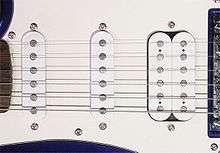
A pickup device is a transducer that captures mechanical vibrations from stringed instruments such as the electric guitar, electric bass guitar, Chapman Stick, or electric violin, and converts them to an electrical signal that is amplified, recorded, or broadcast.
Magnetic pickups
A magnetic pickup consists of a permanent magnet with a core of material such as alnico or ferrite, wrapped with a coil of several thousand turns of fine enameled copper wire. The pickup is most often mounted on the body of the instrument, but can be attached to the bridge, neck or pickguard, as on many electro-acoustic archtop jazz guitars and string basses. The permanent magnet creates a magnetic field; the motion of the vibrating steel strings disturbs the field, and the changing magnetic flux induces a voltage in the coil. This signal is then carried to amplification or recording equipment via a cable. There may also be an internal preamplifier stage between the pickup and cable.
Output
The output voltage of magnetic pickups varies between 100 mV rms to over 1 V rms for some of the higher output types. Some high-output pickups achieve this by employing very strong magnets, thus creating more flux and thereby more output. This can be detrimental to the final sound because the magnet's pull on the strings can cause problems with intonation as well as damp the strings and reduce sustain. Other high-output pickups have more turns of wire to increase the voltage generated by the string's movement. However, this also increases the pickup's output resistance/impedance, which can affect high frequencies if the pickup is not isolated by a buffer amplifier or a DI unit.
Pickup sound

The turns of wire in proximity to each other have an equivalent self-capacitance that, when added to any cable capacitance present, resonates with the inductance of the winding. This resonance can accentuate certain frequencies, giving the pickup a characteristic tonal quality. The more turns of wire in the winding, the higher the output voltage but the lower this resonance frequency. The inductive source impedance inherent in this type of transducer makes it less linear than other forms of pickups, such as piezo-electric or optical. The tonal quality produced by this nonlinearity is, however, subject to taste, and some guitarists and luthiers consider it aesthetically superior to a more linear transducer.
The external load usually consists of resistance (the volume and tone potentiometer in the guitar, and any resistance to ground at the amplifier input) and capacitance between the hot lead and shield in the guitar cable. The electric cable also has a capacitance, which can be a significant portion of the overall system capacitance. This arrangement of passive components forms a resistively-damped second-order low-pass filter. Pickups are usually designed to feed a high input impedance, typically a megohm or more, and a low impedance load reduces the high-frequency response of the pickup because of the filtering effect of the inductance.
Humbuckers
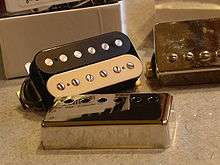
Single coil pickups act like a directional antenna and are prone to pick up mains hum (nuisance electromagnetic interference generated by electrical power cables, power transformers, and fluorescent light ballasts in the area) along with the musical signal. Mains hum consists of a fundamental signal at a nominal 50 or 60 Hz, depending on local alternating current frequency, and usually some harmonic content. The changing magnetic flux caused by the mains current links with the windings of the pickup, inducing a voltage by transformer action. The pickups also are sensitive to the electromagnetic field from nearby cathode ray tubes in video monitors or televisions.
To overcome this effect, the humbucking pickup was invented by Joseph Raymond "Ray" Butts, but Seth Lover of Gibson was also working on one himself. Ray Butts initially developed one on his own and later worked with Gretsch.[1] Who developed it first is a matter of some debate, but Ray Butts was awarded the first patent (U.S. Patent 2,892,371) and Seth Lover came next (U.S. Patent 2,896,491). Ultimately, both men developed essentially the same concept, but Ray Butts was never recognized as the one who produced it first.
A humbucking pickup, shown in the image on the right, is composed of two coils. Each coil is wound reverse to one another. However, the six magnetic poles are opposite in polarity in each winding. Since ambient hum from power-supply transformers, radio frequencies, or electrical devices reaches the coils as common-mode noise, it induces an electric current of equal magnitude in each coil. Because the windings are reversed in each pickup coil, the electro-magnetic interference sine wave signals in each pickup are equal and in antiphase, resulting in them canceling each other. However, the signal from the guitar string is doubled, due to the phase reversal caused by the out of phase magnets. The magnets being out of phase in conjunction with the coil windings being out of phase put the guitar string signal from each pickup in phase with one another. Therefore, the voltage of the signal is approximately doubled, if the two coils are connected in series.
When wired in series, as is most common, the overall inductance of the pickup is increased, which lowers its resonance frequency and attenuates the higher frequencies, giving a less trebly tone (i.e., "fatter") than either of the two component single-coil pickups would give alone. Because the two coils are wired in series, the resulting signal that is output by the pickup is larger in amplitude, thus more able to overdrive the early stages of the amplifier.
An alternative wiring places the coils in buck parallel. The equal common-mode mains hum interference cancels, while the string variation signal sums. This method has a more neutral effect on resonant frequency: mutual capacitance is doubled (which if inductance were constant would lower the resonant frequency), and inductance is halved (which would raise the resonant frequency without the capacitance change). The net is no change in resonant frequency. This pickup wiring is rare,[2] as guitarists have come to expect that humbucking 'has a sound', and is not neutral. On fine jazz guitars, the parallel wiring produces significantly cleaner sound,[2] as the lowered source impedance drives capacitive cable with lower high frequency attenuation.
A side-by-side humbucking pickup senses a wider section of the string (has a wider aperture) than a single-coil pickup. This affects tone.[3] By picking up a larger portion of the vibrating string more lower harmonics are present in the signal produced by the pickup in relation to high harmonics, resulting in a "fatter" tone. Humbucking pickups in the narrow form factor of a single coil, designed to replace single-coil pickups, have the narrower aperture resembling that of a single coil pickup. Some models of these single-coil-replacement humbuckers produce more authentic resemblances to classic single coil tones than full-size humbucking pickups of a similar inductance, which shows that the amount of high-frequency rolloff due to coil inductance is not the only factor in that sound.
Construction
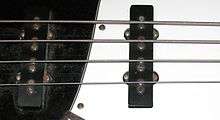
Pickups have magnetic polepieces (with the notable exceptions of rail and lipstick tube pickups—one or two for each string). These polepiece centers should perfectly align with the strings, or sound is suboptimal as the pickup would capture only a part of the string's vibrational energy. An exception to this rule are the J- and P-style pickups (found on the Fender Jazz Bass and Precision Bass, respectively) where the two polepieces per string are positioned on either side of each string.
On most guitars the strings are not aligned in parallel: they converge at the nut and diverge at the bridge. Thus, bridge, neck and middle pickups usually have different polepiece spacings on the same guitar.
There are several standards on pickup sizes and string spacing between the poles. Spacing is measured either as a distance between 1st to 6th polepieces' centers (this is also called "E-to-E" spacing), or as a distance between adjacent polepieces' centers.
| 1st-to-6th | Adjacent | |
|---|---|---|
| Standard spacing (Vintage Gibson guitars) |
1.90" 48 mm |
0.380" 9.6 mm |
| F-spacing (Most Fender guitars, modern Gibson, Floyd Rose bridges) |
2.01" 51 mm |
0.402" 10.2 mm |
| Very close to bridge, extra pickup (Roland guitar synth hex pickups) |
2.060" 52.3 mm |
0.412" 10.5 mm |
| Telecaster spacing (Fender Telecaster guitars) |
2.165" 55 mm |
0.433" 11 mm |
| Steinberger Spirit GT-Pro spacing (may be typical for other Steinberger guitars) |
2.362" 50 mm |
0.3937" 10 mm |
Notation
Most electric guitars have two or three magnetic pickups, although more or less can be found in select models. A combination of pickups is called a pickup configuration. It is usually notated by just writing out the pickup types, using "S" for single-coil and "H" for humbucker, in order from bridge pickup to neck pickup. Popular pickup configurations include:
-

S-S (Fender Telecaster)
-
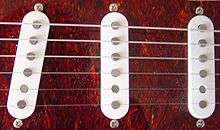
S-S-S (Fender Stratocaster)
-

H-S-S (Superstrats like Fender HM Strat, Peavey Raptor EXP, Peavey Destiny)
-
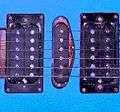
H-S-H (Superstrats)
Less frequently found configurations are:
- S (Fender Esquire, early Gibson Les Paul Juniors, Gibson Melody Maker, some Telecasters)
- H (Gibson ES-165 Herb Ellis, Kramer Baretta, later Les Paul Juniors)
- H-S (Hamer Californian Deluxe, Les Paul BFG, Squier '51)
Examples of rare configurations that only a few particular models use include:
- H-H-H (some Gibson Les Paul Goldtop and Custom models, Gibson SG-3, Gibson ES-5 Switchmaster (after 1957), Kramer Jersey Star, Ibanez Destroyer, Ibanez PGM200)
- H-S-S-H (Music Man Steve Morse Signature)
- H-H-S (some ESP Stephen Carpenter Models and Alembic Jerry Garcia Models)
- S-H-H (some early seven-string ESP Horizons)
- S-H-S (Fender Wayne Kramer Signature)
- S-H (some Telecasters)
- H-S, but with single coil in the middle (one model of Fender Jazzmaster. Ibanez RG2011SC)
- H-S-S, with no space between the middle single coil and the bridge humbucker (Hamer Phantom – angled neck pickup)
Piezoelectric pickups
Sensors

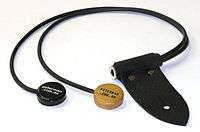
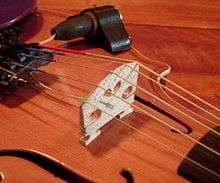
Many semi-acoustic and acoustic guitars, and some electric guitars and basses, have been fitted with piezoelectric pickups instead of, or in addition to, magnetic pickups. These have a very different sound, and also have the advantage of not picking up any other magnetic fields, such as mains hum and feedback from monitoring loops. In hybrid guitars, this system allows switching between magnetic pickup and piezo sounds, or simultaneously blending the output. Solid bodied guitars with only a piezo pickup are known as silent guitars, which are usually used for practicing by acoustic guitarists. Piezo pickups can also be built into electric guitar bridges for conversion of existing instruments.
Most pickups for bowed string instruments, such as cello, violin, and double bass, are piezoelectric. These may be inlaid into the bridge, laid between the bridge feet and the top of the instrument, or, less frequently, wedged under a wing of the bridge. Some pickups are fastened to the top of the instrument with removable putty.
Preamps
Piezoelectric pickups have a very high output impedance and appear as a capacitance in series with a voltage source. They therefore often have an instrument-mounted buffer amplifier fitted to maximize frequency response.
The piezo pickup gives a very wide frequency range output compared to the magnetic types and can give large amplitude signals from the strings. For this reason, the buffer amplifier is often powered from relatively high voltage rails (about ±9 V) to avoid distortion due to clipping. A less linear preamp (like a single-FET amplifier) might be preferable due to softer clipping characteristics.[4] Such an amplifier starts to distort sooner, which makes the distortion less "buzzy" and less audible than a more linear, but less forgiving op-amp. However, at least one study[5] indicates that most people can not tell the difference between FET and op-amp circuits in blind listening comparisons of electric instrument preamps, which correlates with results of formal studies of other types of audio devices. Sometimes, piezoelectric pickups are used in conjunction with magnetic types to give a wider range of available sounds.
For early pickup devices using the piezoelectric effect, see phonograph.
Other transducers
Some pickup products are installed and used similarly to piezoelectric pickups, but use different underlying technology, for instance electret[6] or condenser microphone technology.[7]
Double systems pickups
There are basically four principles used to convert sound into an alternating current, each with their pros and cons:
- A microphone registers the vibrations of the air caused by the instrument. In general this technique guarantees a good sound quality, but with two limitations: feedback and crosstalk.
- Contact pickups register the vibrations of the instrument itself. They have the advantage of producing little feedback and no crosstalk at all. In spite of their lesser sound quality and thanks to their low price, contact pickups (and especially the piezoelectric pickup) have become the most popular transducer.
- Magnetic pickups. Magnetic pickups, as applied in electric guitars, register the vibrations of nickel or steel strings in a magnetic field. They have the advantage that they can be connected directly to an (electric guitar) amplifier, but in combination with a steel-string acoustic guitar the sound tends to be electric. This is why acoustic guitarists typically choose a piezoelectric pickup, built in microphone, or both.
- Electrostatic pickups. Another way is to use the changing capacitance between the string and a pickup plate. These electronic pickups produce much higher dynamics than conventional pickups, so the difference between a soft and a loud pick strike is more pronounced than with other types of pickups.
An amplification system with two transducers combines the qualities of both. A combination of a microphone and a piezoelectric pickup typically produces better sound quality and less sensitivity to feedback, as compared to single transducers. However, this is not always the case. A less frequently used combination is a piezoelectric and a magnetic pickup. This combination can work well for a solid sound with dynamics and expression. Examples of a double system amplifier are the Highlander iP-2, the Verweij VAMP or the LR Baggs dual source and the D-TAR Multisource.[8]
Multi-transducer pickups
Hexaphonic pickups (also called divided pickups and polyphonic pickups) have a separate output for each string (Hexaphonic assumes six strings, as on a guitar). This allows for separate processing and amplification for each string. It also allows a converter to sense the pitch coming from individual string signals for producing note commands, typically according to the MIDI (musical instrument digital interface) protocol. A hexaphonic pickup and a converter are usually components of a guitar/synthesizer.
Such pickups are uncommon (compared to normal ones), and only a few notable models exist, like the piezoelectric pickups on the Moog Guitar. Hexaphonic pickups can be either magnetic or piezoelectric or based on the condensor principle like electronicpickups
Optical
Optical pickups are a fairly recent development that work by sensing the interruption of a light beam by a vibrating string. The light source is usually a LED, and the detector is a photodiode or phototransistor.[9] These pickups are completely resistant to magnetic or electric interference and also have a very broad and flat frequency response, unlike magnetic pickups.
Optical pickup guitars were first shown at the 1969 NAMM in Chicago, by Ron Hoag.[10]
In 2000, Christopher Willcox, founder of LightWave Systems, unveiled a new beta technology for an optical pickup system using infrared light. In May 2001, LightWave Systems released their second generation pickup, dubbed the "S2." The S2 featured LightWave Systems' monolithic bridge, six-channel motherboard, and a host of other improvements, making the technology more practical for use in both live and recording studio settings.[11]
Active and passive pickups
Pickups can be either active or passive. Pickups, apart from optical types, are inherently passive transducers. "Active" pickups incorporate electronic circuitry to modify the signal. "Passive" pickups are usually wire wound around a magnet, and are the most common type used. They can generate electric potential without need for external power, though their output is relatively low, and the harmonic content of output depends greatly on the winding.

Active pickups require an electrical source of energy (usually one or two 9V batteries) to operate and include an electronic preamp, active filters, active EQ and other sound-shaping features. They can sometimes give much higher possible output. They also are less affected in tone by varying lengths of the electric cable connecting the guitar to the amplifier, and amplifier input characteristics. Magnetic pickups used with 'active' circuitry usually feature a lower inductance (and initially lower output) winding that tends to give a flatter frequency response curve.
The main disadvantages of active pickup system are that the systems require external power sourced to operate the active circuitry. The guitars with active pickups may contain audio filters, which reduce the dynamic range and mildly distorte certain ranges. High output active pickup systems also have an effect on an amplifiers input circuit. This is all to taste.
The main advantages of active pickup systems are the presence of high pass and low pass audio filters. Active pickup systems with audio filters are much more suited to high levels of sound processing by cutting out lows in a bridge pickup and cutting out highs on a neck pickup, keeping distortion effects (bridge) crispy and chorus effects smooth and warm (neck). Active pickup systems may also contain a feedback loop, to seemlessly electronically increase sustain. Active pickup systems have several hum reducing RF filters and ground loops. Active pickups systems contain preamplifier circuitry to increase pickup output, reducing signal loss and interference. Many guitars with active pickup systems do not have tone knobs, making it simpler to access the pickup selector.
Many bass players, notably Stanley Clarke, Flea, Victor Wooten, Abraham Laboriel and Doug Wimbish used active bass pickups to produce their characteristic bass tones. Players who use active pickups for electric guitar include Mick Thomson (Slipknot), James Hetfield (Metallica), Dino Cazares (Fear Factory) and Dave Mustaine (Megadeth).
Stereo and multiple pickups with individual outputs
Rickenbacker was the first manufacturer who began producing stereo bass guitars with a stereo output for each pickup section. The neck pickup had one output and the bridge pickup had one. Also Teisco produced a guitar with a stereo option. Teisco divided the two sections in the upper three strings and the lower three strings for each individual output. The Gittler guitar was an experimental guitar with six pickups, one for each string. The Go! Team has modified a Fender Telecaster with an additional rotated pickup for the upper string, causing a simulation of a one string bass sound. Gibson also created the HD.6X Pro guitar with The Hex Pickup that captures a separate signal for each individual string and sends it to the onboard analog/digital converter, which uses Gibson's digital transport technology to send the signal out of the guitar via Cat 5 Ethernet Cable. The output can be routed as a single summed mono signal to an amplifier or recording console. It can also send the E, A, and D strings to one amp or recording channel and the G, B, and high E to a separate amp or channel. Or it can send the output of all six individual strings to six different amps or channels. These six individualized outputs can used to create various effects.
See also
- Contact microphone
- DiMarzio
- Electric lamellophone
- Electric sitar
- EMG
- Humbucker
- Instrument amplifier
- Kinman Guitar Electrix
- Lace Sensor
- Lipstick pickup
- List of electronics topics
- Magnetic circuit
- Nominal impedance
- Preamplifier
- Reverberation
- Seymour Duncan
- Single coil
- Transformer
Notes
- ↑ Wheeler. p.214
- 1 2 humbucker
- ↑ Tillman, Donald (2002).
- ↑ Discrete FET Guitar Preamp
- ↑ Mottola, R.M. (2003). "A Listening Evaluation of Discrete vs Integrated Circuit Audio Preamplifiers in Stringed Musical Instruments". Journal of Musical Instrument Technology (23).
- ↑ B-Band electret pickup
- ↑ Schertler Bluestick
- ↑ http://www.amplifyingacoustics.nl/page/about-the-amplification
- ↑ "LightWave Systems | Technology". Retrieved 13 September 2012.
- ↑ Wallace, Joe (2006-12-11). "Light Speed Guitars: The Story Of Ron Hoag And His Optical Guitar Pickup". Gearwire. Retrieved 2009-06-09.
- ↑ "About | LightWave Systems". Retrieved 2012-09-13.
References
- Brosnac, Donald (1980 a). Guitar Electronics: A Workbook. Ojai, CA: d.B. Music Co. ISBN 0-933224-02-8. Check date values in:
|date=(help)
- Tillman, Donald (2002). Response Effects of Guitar Pickup Position and Width
- Wheeler, Tom (1992). American Guitars: an illustrated history. Harper. New York ISBN 0-06-273154-8
External links
| Wikimedia Commons has media related to Guitar pickups. |
- Guitar Pickup Simulation
- Hi-Hend piezo pickups TAV. Middle impedanze
- Guitar Pickup - Interactive Tutorial National High Magnetic Field Laboratory
- Properties of Magnetic Materials (chapter)
- Basic Electric Guitar Circuits - Pickups
